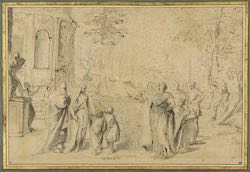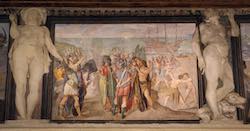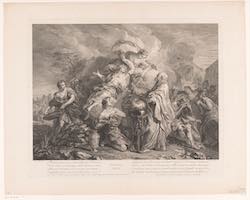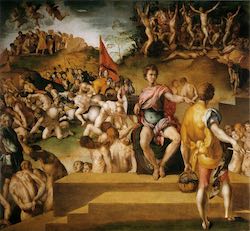Topic: 2. Sacrifice and religion: Comparisons, Antiquarians, Anthropology (16th-18th Century)
Religious sacrifices across various cultures and contexts sparked widespread interest in Early Modern Europe. As Christianity expanded into regions inhabited by "infidels" and "pagans", Europeans encountered a diverse array of sacrificial customs, ranging from the Sati rituals in India to the Aztec sacrifices in the Americas. This cross-cultural exposure captivated a wide audience, including theologians, philosophers, political thinkers, antiquarians, orientalists, missionaries, poets, artists, and even the general public. These encounters broadened the European understanding of sacrifice and led to a critical reassessment of classical and biblical sacrificial rites. This section includes:
- Sources: A selection of early modern printed materials, which include descriptions of the Americas, Asia, and Africa, alongside antiquarian and philological studies on religious sacrifice in classical antiquity and beyond. It also presents early modern works of ethnological observations and the first attempts to compare different sacrificial practices in various traditions and contexts, laying the groundwork for disciplines like the history of religions and anthropology.
- Iconographic Representations: A rich collection of images from the 16th to 18th centuries, illustrating a range of sacrificial rituals and practices as seen in different cultural and geographical contexts.
- Related Bibliography: An extensive bibliography spanning scholarly works from the 19th to 21st centuries, providing contemporary analyses and interpretations of these early studies and observations.
The sacrificial sheep in three French-North African films: displacements and reappropriations
in: Journal of African Cinemas, v. 8 (2016), issue 1: pp.57-73.
Human Sacrifice
in: The Encyclopaedia of Religion, pp. 515-523
New York: Macmillan, 1987.
0. General bibliography (19th-21th Century) 2. Sacrifice and religion: Comparisons, Antiquarians, Anthropology (16th-18th Century)
Sacrifice/Human Sacrifice in Religious Traditions
in: The Oxford Handbook of Religion and Violence, pp. 209-225
New York: Oxford University Press, 2013.
Human sacrifice: Aztec rites
in: Encyclopedia of Religion, pp. 4185–4191
Detroit: Thomson Gale, 2005.
Old World Christian Ritual and Sacrifice in the New World: Symbolization Processes in Sixteenth-Century Central Mexico
in: Sacrifice and Conversion in the Early Modern Atlantic, pp. 59-88
Florence: Harvard University Press- Villa I Tatti, 2022.
Le imagini con la spositione de i Dei de gli antichi
Venice: Giordano Ziletti, 1556.
I diecimila martiri, San Maurizio e il massacrodella legione tebana (1528-1530)
from: Catalogo generale dei beni culturali
Galleria palatina, Firenze
Recherches sur le vocabulaire des sacrifices en Grec des origines à la fin de l'époque classique
Paris: Faculté des lettres et des sciences humaines, 1966.
The originall of idolatries: or, The birth of heresies: a true, sincere, and exact description of all such sacred signes, sacrifices, and sacraments as haue been instituted and ordained of God since Adam
London: George Purslowe ; Miles Flesher, 1624.
The binding (aqedah) and its transformations in Judaism and Islam: the lambs of God
Lewiston, Queenston & Lampeter: Mellen Biblical, 1995.
Martyrdom and Memory: Early Christian Culture Making
New York: Columbia University Press, 2004.
The ambivalent legacy of violence and victimhood. Using early Christian martyrs to think with
in: Spiritus, v. 6 (2006), issue : pp.1 - 24.




